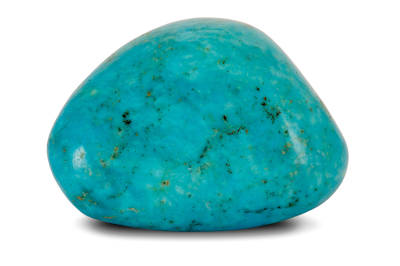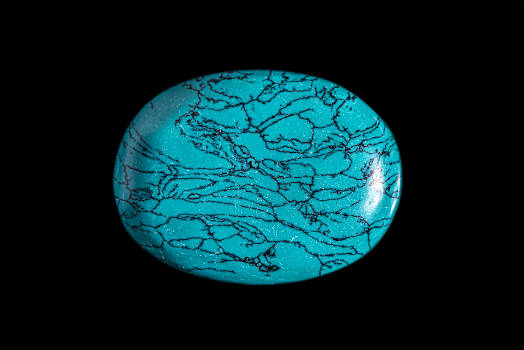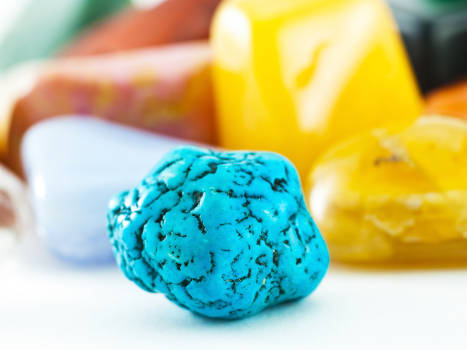Turquoise is possibly best known for its role in the art and jewelry of the people indigenous to the Southwestern United States.
Combined with silver and red jasper, turquoise’s bold blue-green hue provides a strikingly beautiful contrast evocative of the endless desert sky.
This stone is good for more than its aesthetic value alone, however — for ages, it has served as a sacred tool, a source of healing, and a font of magical power.
About Turquoise
Turquoise is a hydrated phosphate of aluminum and copper. It has a cryptocrystalline structure, and so never forms individual crystals.
This stone also has a tendency to be porous and variable in density and hardness, so it’s common practice to stabilize softer specimens by adding resin to enhance their color and protect them.
While the word “turquoise” has become synonymous with a shade of blue-green, actual turquoise can vary widely in color — from green, to blue, to blue-green, to yellowish green, to white.

Since turquoise is such a valuable stone, the market is somewhat flooded with imitations. Stabilized turquoise is genuine turquoise, but usually made using softer, lower-quality stones as a base.
Many cheaper turquoise specimens are actually dyed howlite or magnesite, which is a softer stone. Some others are cheap stones dipped in powdered turquoise dispersed in a resin binder, effectively creating a “shell” around the original mineral.
Some jewelry may even be entirely plastic or resin, and contain no stone at all.
See also: Check out Turquoise stones here.
Turquoise Healing Properties & Benefits
As an emotional healer, turquoise helps one prioritize their physical and mental health. It’s strongly associated with the element of water, which is life-giving.
Working with turquoise is said to facilitate making the healthiest choices for the mind, body, and spirit. It’s also used to relieve stress, boost vitality, stabilize moods, and remove negative energy.
Physically, turquoise is said to clear harmful electromagnetic smog. It’s used to help exhaustion and increase the assimilation of needed nutrients.
This stone is also purported to alleviate inflammatory issues, viral infections, and problems involving the brain, ears, eyes, and lungs. It’s a generally balancing, cleansing, and stabilizing influence, helping to calm overactive systems while bolstering underactive ones.
See also: Check out Turquoise jewelry here.
Turquoise Magical Properties
Magically, turquoise often serves as an indicator. It’s sometimes used in love spells, or to tell when a relationship is on the rocks — if the stone’s color dulls or changes, it can signify changes between partners.
Similarly, it’s used as protector and predictor of health. If the stone’s vibrant blue turns a sickly green or pale color, the user is under attack from an illness.
Some use turquoise as a divinatory aid. To do this, hold the stone in the left hand, clear your mind, and focus on a question. After a moment, open your eyes and look to the stone. You will suddenly receive an answer or hint.
Turquoise is also sometimes used as a wealth stone. Keeping it in a wallet, bank, or safe is said to attract money and prosperity.

As a blue stone, turquoise can be used to work with the element of water, or even to represent this element during ritual. It’s also suitable in spells for communication, focus, forgiveness, cleansing, and harmony within the home.
For those who work with chakras, turquoise is tied to the throat chakra, Visuddha.
Its chakra correspondence overlaps with its healing and magical properties — it’s associated with the throat chakra, used to heal allergies and organs associated with breath, and employed in magic to improve communication.
This makes it helpful for those who have difficulty talking to others, or suffer from the fear of public speaking.
Those who exhibit symptoms of a blocked or unbalanced throat chakra should wear turquoise jewelry near this area, or place a stone at the throat during meditation.
It’s considered best to wear turquoise close to the skin in order to experience its full power.
Turquoise History & Folklore
This stone has many names. To Pliny the Elder, the mineral was called calais (Calaïs was also the name of one of the Boreads, the sons of the North Wind).
To the Aztecs, it was chalchihuitl. The word turquoise comes from a French word for “Turkish,” since this stone was introduced to Europe from Iran via Turkey.
To the Apache people, attaching turquoise (duklij) to a bow increased the shooter’s accuracy. If a shaman didn’t have a turquoise stone, they wouldn’t receive the proper recognition.
One legend tells of a terrible drought. Once the rains finally came, the people were so ecstatic that they celebrated, weeping tears of joy all the while. Their tears mingled with the rains and sank into the soil, where they formed turquoise gems.
A Franciscan missionary named Juan de Torquemada wrote that the Aztec people made offerings of this stone at the temple to the Goddess Matlalcueye. They believed that the God Quetzalcoatl taught them the secret of carving turquoise.
A Zuni legend tells the story of Turquoise Man and Salt Woman, who felt they weren’t valued enough by people. As a result, they went away, so humans could only find them with great effort.
How to Cleanse Turquoise
Genuine turquoise is fairly easy to cleanse — the tricky part comes from dealing with the number of imitators out there.
For the most part, this stone can handle a range of energy clearing methods, though it’s said that it prefer to be placed in a bowl of tumbled hematite stones.
Some methods for cleansing Turquoise include:
- Bathing it in fresh, running water. Natural rivers, streams, spring water, ocean water, rainfall, or snowmelt are preferable to tap water.
- Burying it in dried cleansing herbs.
- Bathing it in an infusion of cleansing herbs. Steep your favorite herbs in fresh, hot water (or place them in sunlight, to make a kind of sun tea). Strain the herbs, and use the resulting liquid to cleanse your stones.
- Fumigating it with cleansing herbs or incense smoke.
- Using your personal energy.
- Placing music, singing bowls, chimes, or bells.
It should be noted that, since turquoise is a hydrate, its properties can change if it loses water. For this reason, it’s best not to place it in direct sunlight or areas with a lot of heat. This may cause the stone’s color to change, and it can become brittle.
Getting Started With Turquoise
Tradition holds that the best way to get a turquoise is to receive it as a gift, so you may wish to avoid purchasing your own specimen.
If you do, you should be aware that a lot of turquoise stones aren’t genuine — it’s important to know how to tell a real one from a fake, even if you won’t be able to perform most of these tests before purchase.
There are a number of ways to tell whether your turquoise is genuine. The first is the presence of a dark matrix. Genuine turquoise typically has veins of darker stone intermingled with the blue.
Another test involves using a needle and a heat source. You can hold the needle in the heat source until it’s hot, then press it against the stone. Genuine stone won’t burn, but resin may begin to melt, char, or smell like burning plastic.

Telling turquoise from a dyed stone is a bit trickier. For this, you’ll need a cotton swab and some acetone (typically found in nail polish remover).
Dip the swab in the acetone, and dab it on a discreet place on the stone. If the blue color transfers to the swab, the stone has been dyed.
Lastly, take a look at the price. If a stone seems unusually inexpensive, or just too good of a deal to be true, it’s either fake or unethically harvested.
Cheap crystals are typically cheap because they’re man-made, being passed off as a more expensive mineral, or mined using exploitative practices. Either way, pass them by.
When you have your stone, give it a good energy cleansing. This will remove any traces of energies from the mining, polishing, and shipping process.
You’ll be able to start working with your turquoise in its most natural, energetically neutral state, which will make it more effective for you.
At this point, you can do as you like. If you want to attract prosperity, include your stone in a money-drawing ritual, then keep it in your purse or wallet.
To safeguard your health and combat stress and exhaustion, wear it as jewelry or keep it close to your skin. To heal a specific body part, place it on top of the area in need of help.
If you aren’t sure what you want to do, try meditating with your stone. Clear your mind, and let your energy gently reach out to it. Chances are, it will let you know how it’d like to work with you.
Turquoise stones are found all over the world and, historically, have been prized more highly than gold. They are divinatory aids, stones of power, and tools for healing.
If you come across a genuine turquoise, keep it well. They are extremely precious, and very powerful.
As an Amazon Associate, Terravara earns from qualifying purchases at no additional cost to readers.
